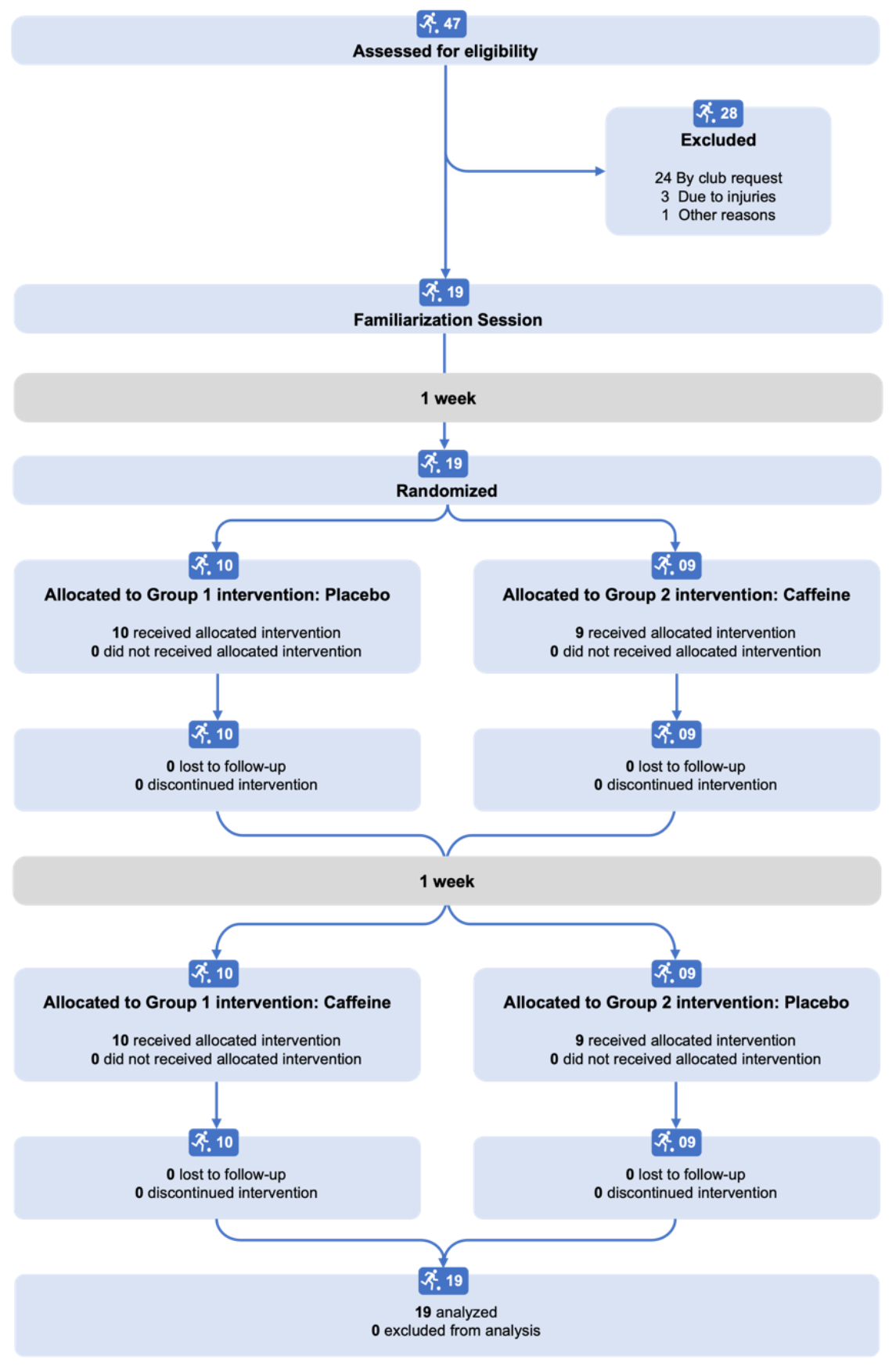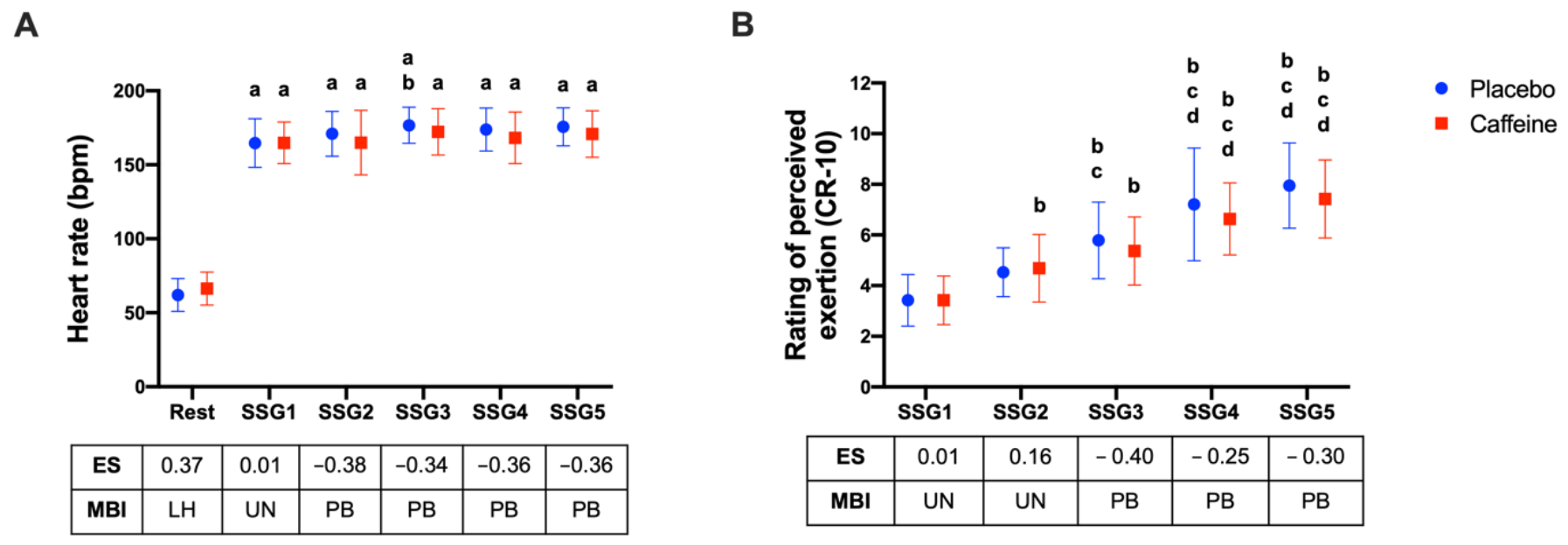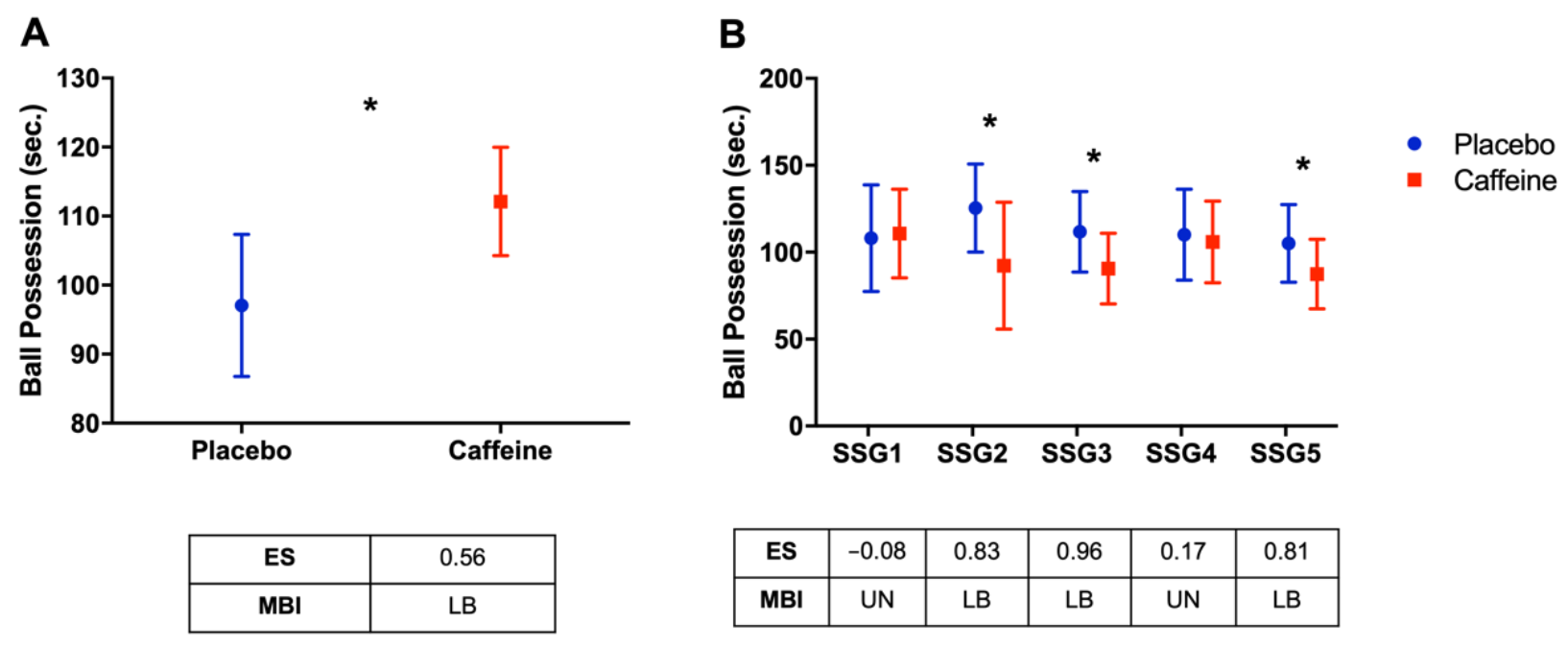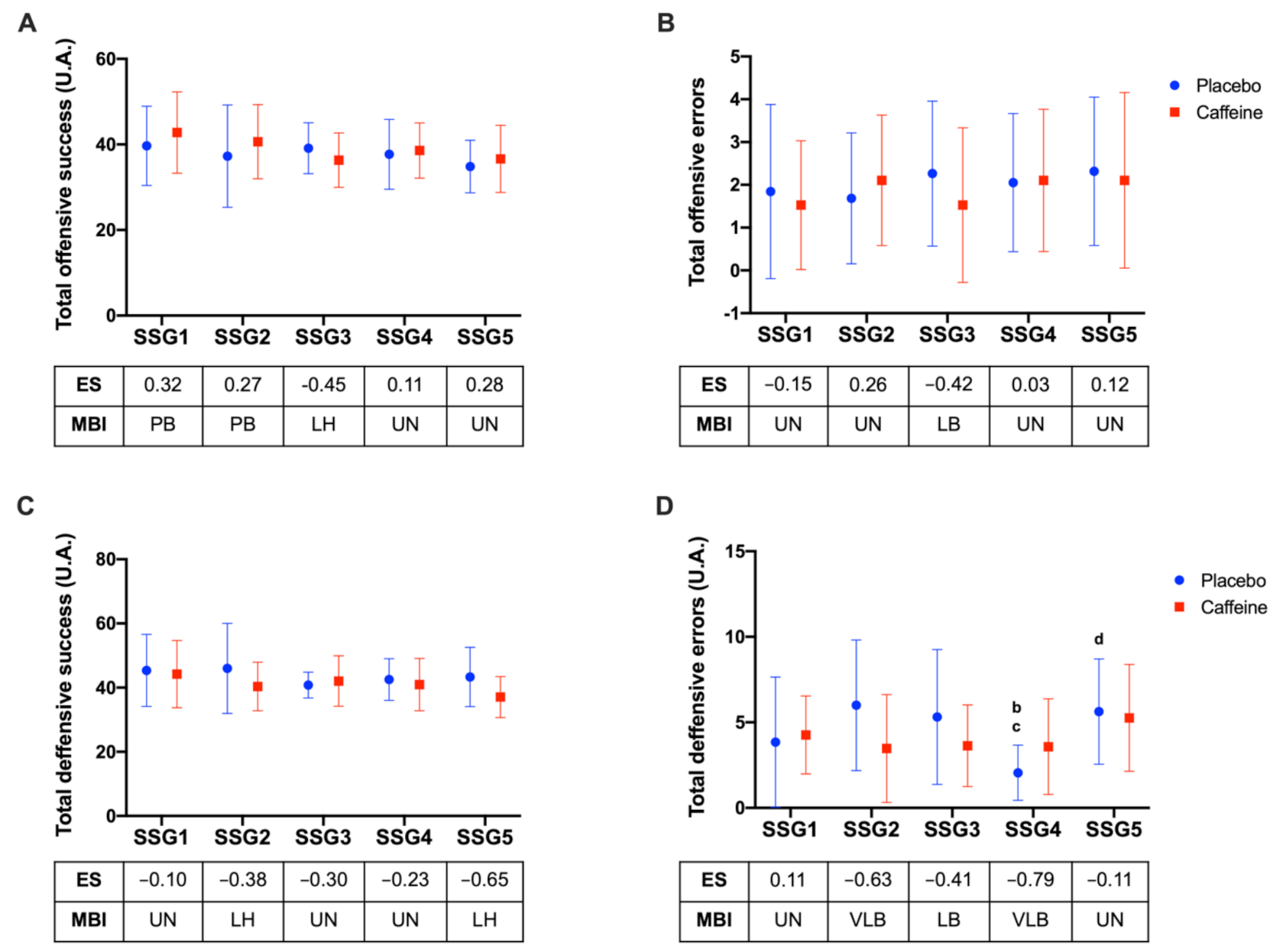The Effect of Acute Caffeine Ingestion on Tactical Performance of Professional Soccer Players
Abstract
:1. Introduction
2. Materials and Methods
2.1. Subjects
2.2. Design and Procedures
2.3. Tactical Performance
2.4. Statistical Analysis
3. Results
3.1. Physiological and Subjective Performance
3.2. Tactical Performance
4. Discussion
5. Conclusions
Author Contributions
Funding
Institutional Review Board Statement
Informed Consent Statement
Data Availability Statement
Acknowledgments
Conflicts of Interest
References
- Burke, L.M. Caffeine and Sports Performance. Appl. Physiol. Nutr. Metab. 2008, 33, 1319–1334. [Google Scholar] [CrossRef] [PubMed]
- Graham, T.E. Caffeine and Exercise Metabolism, Endurance and Performance. Sports Med. 2001, 31, 785–807. [Google Scholar] [CrossRef] [PubMed]
- Lorenzo Calvo, J.; Fei, X.; Domínguez, R.; Pareja-Galeano, H. Caffeine and Cognitive Functions in Sports: A Systematic Review and Meta-Analysis. Nutrients 2021, 13, 868. [Google Scholar] [CrossRef] [PubMed]
- Gant, N.; Ali, A.; Foskett, A. The Influence of Caffeine and Carbohydrate Coingestion on Simulated Soccer Performance. Int. J. Sport Nutr. Exerc. Metab. 2010, 20, 191–197. [Google Scholar] [CrossRef]
- Duvnjak-Zaknich, D.M.; Dawson, B.T.; Wallman, K.E.; Henry, G. Effect of Caffeine on Reactive Agility Time When Fresh and Fatigued. Med. Sci. Sports Exerc. 2011, 43, 1523–1530. [Google Scholar] [CrossRef]
- Foskett, A.; Ali, A.; Gant, N. Caffeine Enhances Cognitive Function and Skill Performance during Simulated Soccer Activity. Int. J. Sport Nutr. Exerc. Metab. 2009, 19, 410–423. [Google Scholar] [CrossRef]
- Tallis, J.; Clarke, N.; Morris, R.; Richardson, D.; Ellis, M.; Eyre, E.; Duncan, M.; Noon, M. The Prevalence and Practices of Caffeine Use as an Ergogenic Aid in English Professional Soccer. Biol. Sport 2021, 38, 525–534. [Google Scholar] [CrossRef]
- Stratton, G.; Reilly, T.; Richardson, D.; Williams, A.M. Youth Soccer: From Science to Performance; Psychology Press: Hove, UK, 2004; ISBN 978-0-415-28661-9. [Google Scholar]
- Machado, G.; González-Víllora, S.; Sarmento, H.; Teoldo, I. Development of Tactical Decision-Making Skills in Youth Soccer Players: Macro- and Microstructure of Soccer Developmental Activities as a Discriminant of Different Skill Levels. Int. J. Perform. Anal. Sport 2020, 20, 1072–1091. [Google Scholar] [CrossRef]
- Del Coso, J.; Muñoz-Fernández, V.E.; Muñoz, G.; Fernández-Elías, V.E.; Ortega, J.F.; Hamouti, N.; Barbero, J.C.; Muñoz-Guerra, J. Effects of a Caffeine-Containing Energy Drink on Simulated Soccer Performance. PLoS ONE 2012, 7, e31380. [Google Scholar] [CrossRef]
- Guerra, M.A.; Caldas, L.C.; De Souza, H.L.; Vitzel, K.F.; Cholewa, J.M.; Duncan, M.J.; Guimarães-Ferreira, L. The Acute Effects of Plyometric and Sled Towing Stimuli with and without Caffeine Ingestion on Vertical Jump Performance in Professional Soccer Players. J. Int. Soc. Sports Nutr. 2018, 15, 3–9. [Google Scholar] [CrossRef] [Green Version]
- Lara, B.; Gonzalez-Millán, C.; Salinero, J.J.; Abian-Vicen, J.; Areces, F.; Barbero-Alvarez, J.C.; Muñoz, V.; Portillo, L.J.; Gonzalez-Rave, J.M.; Del Coso, J. Caffeine-Containing Energy Drink Improves Physical Performance in Female Soccer Players. Amino Acids 2014, 46, 1385–1392. [Google Scholar] [CrossRef] [PubMed]
- Mielgo-Ayuso, J.; Calleja-Gonzalez, J.; Del Coso, J.; Urdampilleta, A.; León-Guerreño, P.; Fernández-Lázaro, D. Muscle Damage and Perception of Fatigue in Soccer Players: A Systematic Review. Nutrients 2019, 11, 440. [Google Scholar] [CrossRef] [Green Version]
- Jones, S.R.; Carley, S.; Harrison, M. An Introduction to Power and Sample Size Estimation. Emerg. Med. J. 2003, 20, 453–458. [Google Scholar] [CrossRef] [PubMed]
- Maughan, R.J. Nutritional Ergogenic Aids and Exercise Performance. Nutr. Res. Rev. 1999, 12, 255–280. [Google Scholar] [CrossRef] [PubMed] [Green Version]
- Drust, B.; Waterhouse, J.; Atkinson, G.; Edwards, B.J.; Reilly, T. Circadian Rhythms in Sports Performance—An Update. Chronobiol. Int. 2005, 22, 21–44. [Google Scholar] [CrossRef]
- Klauss, J.; Cleres, L.; Pinheiro, P.; Lima, B.; Merlo, S.; De Almeida, G.; Santos, C.; Fregni, F.; Nitsche, M.A.; Nakamura-Palacios, E.M. A Randomized Controlled Trial of Targeted Prefrontal Cortex Modulation with TDCS in Patients with Alcohol Dependence. Int. J. Neuropsychopharmacol. 2014, 17, 1793–1803. [Google Scholar] [CrossRef]
- Foster, C.; Florhaug, J.A.; Franklin, J.; Gottschall, L.; Hrovatin, L.A.; Suzanne, P.; Doleshal, P.; Dodge, C. A New Approach to Monitoring Exercise Training. J. Strength Cond. Res. 2001, 15, 109–115. [Google Scholar]
- da Costa, I.T.; Garganta, J.; Greco, P.J.; Mesquita, I. Proposta de avaliação do comportamento tático de jogadores de futebol baseada em princípios fundamentais do jogo. Mot. Rev. Educ. Física 2011, 17, 511–524. [Google Scholar] [CrossRef]
- Teoldo, I.; Guilherme, J.; Garganta, J. Training Football for Smart Playing: On Tactical Performance of Teams and Players; Appris: Curitiba, Brazil, 2017. [Google Scholar]
- da Costa, I.T.; da Silva, J.M.; Greco, P.J.; Greco, P.; Mesquita, I. Tactical Principles of Soccer Game: Concepts and Application. Motriz 2009, 15, 657–668. [Google Scholar] [CrossRef]
- Costa, I.T.; Garganta, J.; Greco, P.J.; Mesquita, I.; Maia, J. Sistema de Avaliação Táctica No Futebol (FUT-SAT): Desenvolvimento e Validação Preliminar. Motricidade 2011, 7, 69–84. [Google Scholar] [CrossRef] [Green Version]
- dos Gonzaga, A.S.; Albuquerque, M.R.; Malloy-Diniz, L.F.; Greco, P.J.; da Costa, I.T. Affective Decision-Making and Tactical Behavior of under-15 Soccer Players. PLoS ONE 2014, 9, e101231. [Google Scholar] [CrossRef] [PubMed] [Green Version]
- Hopkins, W.G.; Marshall, S.W.; Batterham, A.M.; Hanin, J. Progressive Statistics for Studies in Sports Medicine and Exercise Science. Med. Sci. Sports Exerc. 2009, 41, 3–13. [Google Scholar] [CrossRef] [PubMed] [Green Version]
- Dellal, A.; Owen, A.; Wong, D.P.; Krustrup, P.; Van Exsel, M.; Mallo, J. Technical and Physical Demands of Small vs. Large Sided Games in Relation to Playing Position in Elite Soccer. Hum. Mov. Sci. 2012, 31, 957–969. [Google Scholar] [CrossRef] [PubMed]
- Huertas, F.; Blasco, E.; Moratal, C.; Lupiañez, J. Caffeine Intake Modulates the Functioning of the Attentional Networks Depending on Consumption Habits and Acute Exercise Demands. Sci. Rep. 2019, 9, 10043. [Google Scholar] [CrossRef]
- Royall, D.R.; Lauterbach, E.C.; Cummings, J.L.; Reeve, A.; Rummans, T.A.; Kaufer, D.I.; Lafrance, W.C.; Coffey, C.E. Executive Control Function: A Review of Its Promise and Challenges for Clinical Research. J. Neuropsychiatry Clin. Neurosci. 2002, 14, 377–405. [Google Scholar] [CrossRef]
- Wang, C.; Chang, C.; Liang, Y.; Shih, C.; Chiu, W.; Tseng, P.; Hung, D.L.; Tzeng, O.J.L.; Muggleton, N.G.; Juan, C. Open vs. Closed Skill Sports and the Modulation of Inhibitory Control. PLoS ONE 2013, 8, 4–13. [Google Scholar] [CrossRef] [Green Version]
- Mostofsky, S.H.; Simmonds, D.J. Response Inhibition and Response Selection: Two Sides of the Same Coin. J. Cogn. Neurosci. 2008, 25, 751–761. [Google Scholar] [CrossRef] [PubMed]
- Gantois, P.; Caputo Ferreira, M.E.; Lima-Junior, D.D.; Nakamura, F.Y.; Batista, G.R.; Fonseca, F.S.; Fortes, L.D. Effects of Mental Fatigue on Passing Decision-Making Performance in Professional Soccer Athletes. Eur. J. Sport Sci. 2019, 20, 534–543. [Google Scholar] [CrossRef]
- Vestberg, T.; Gustafson, R.; Maurex, L.; Ingvar, M.; Petrovic, P. Executive Functions Predict the Success of Top-Soccer Players. PLoS ONE 2012, 7, e34731. [Google Scholar] [CrossRef]
- Coutinho, D.; Gonçalves, B.; Travassos, B.; Wong, D.P.; Coutts, A.J.; Sampaio, J.E. Mental Fatigue and Spatial References Impair Soccer Players’ Physical and Tactical Performances. Front. Psychol. 2017, 8, 1645. [Google Scholar] [CrossRef] [Green Version]
- Kunrath, C.A.; Nakamura, F.Y.; Roca, A.; Tessitore, A.; Teoldo Da Costa, I. How Does Mental Fatigue Affect Soccer Performance during Small-Sided Games? A Cognitive, Tactical and Physical Approach. J. Sports Sci. 2020, 38, 1818–1828. [Google Scholar] [CrossRef] [PubMed]
- Badin, O.O.; Smith, M.R.; Conte, D.; Coutts, A.J. Mental Fatigue Impairs Technical Performance in Small-Sided Soccer Games. Int. J. Sports Physiol. Perform. 2016, 11, 1100–1105. [Google Scholar] [CrossRef] [PubMed]
- Smith, M.R.; Zeuwts, L.; Lenoir, M.; Hens, N.; Laura, M.S.; Jong, D.; Coutts, A.J.; Smith, M.R.; Zeuwts, L.; Lenoir, M.; et al. Mental Fatigue Impairs Soccer-Specific Decision-Making Skill. J. Sports Sci. 2016, 34, 1297–1304. [Google Scholar] [CrossRef] [PubMed]
- Pageaux, B.; Lepers, R. The Effects of Mental Fatigue on Sport-Related Performance. Prog. Brain Res. 2018, 240, 291–315. [Google Scholar] [CrossRef] [PubMed]
- Russell, S.; Jenkins, D.; Smith, M.; Halson, S.; Kelly, V. The Application of Mental Fatigue Research to Elite Team Sport Performance: New Perspectives. J. Sci. Med. Sport 2019, 22, 723–728. [Google Scholar] [CrossRef]
- Yerkes, R.M.; Dodson, J.D. The relation of strength of stimulus to rapidity of habit-formation. J. Comp. Neurol. Psych. 1908, 18, 459–482. [Google Scholar] [CrossRef] [Green Version]
- Apostolidis, A.; Mougios, V.; Smilios, I.; Rodosthenous, J.; Hadjicharalambous, M. Caffeine Supplementation: Ergogenic in Both High and Low Caffeine Responders. Int. J. Sports Physiol. Perform. 2018, 14, 650–657. [Google Scholar] [CrossRef]
- Barry, R.J.; Rushby, J.A.; Wallace, M.J.; Clarke, A.R.; Johnstone, S.J.; Zlojutro, I. Caffeine Effects on Resting-State Arousal. Clin. Neurophysiol. 2005, 116, 2693–2700. [Google Scholar] [CrossRef]
- Shabir, A.; Hooton, A.; Tallis, J.; Higgins, F.M. The Influence of Caffeine Expectancies on Sport, Exercise, and Cognitive Performance. Nutrients 2018, 10, 1528. [Google Scholar] [CrossRef] [Green Version]
- Saunders, B.; de Oliveira, L.F.; da Silva, R.P.; de Salles Painelli, V.; Gonçalves, L.S.; Yamaguchi, G.; Mutti, T.; Maciel, E.; Roschel, H.; Artioli, G.G.; et al. Placebo in Sports Nutrition: A Proof-of-Principle Study Involving Caffeine Supplementation. Scand. J. Med. Sci. Sports 2017, 27, 1240–1247. [Google Scholar] [CrossRef]
- Mikalsen, A.; Bertelsen, B.; Flaten, M. Effects of Caffeine, Caffeine-Associated Stimuli, and Caffeine-Related Information on Physiological and Psychological Arousal. Psychopharmacology 2001, 157, 373–380. [Google Scholar] [CrossRef] [PubMed]
- Pickering, C.; Grgic, J. Caffeine and Exercise: What Next? Sports Med. 2019, 49, 1007–1030. [Google Scholar] [CrossRef] [PubMed] [Green Version]




| Phases of Play | Principles | Description |
|---|---|---|
| Offensive | Penetration | Reduction of the distance between the player in possession of the ball and the opponent’s goal or goal line. |
| Offensive Coverage | Providing offensive support to the player in possession. | |
| Depth Mobility | Generation of organizational instability in the opposing defense. | |
| Width and Length without the ball | Utilization and increase of the effective play-space in width and depth. | |
| Offensive Unity | Progression movements or offensive support by the player (s) who compose (s) the last transversal line (s) of the team. | |
| Defensive | Delay | Opposition to the player in possession. |
| Defensive Coverage | Providing defensive support to the player performing delay. | |
| Balance | Numerical stability or superiority in opposition relations. | |
| Concentration | Increase of defensive protection within the riskier zone to the goal. | |
| Defensive Unity | Reduction of the opposition’s effective play-space. |
| Phase | Core Tactical Principles | Principle Location | Detailed Performance | Placebo (ME ± SD) | Caffeine (ME ± SD) | MBI-Value (Classification) |
|---|---|---|---|---|---|---|
| Offensive Principles | Penetration | ICP | TPI | 45.38 ± 21.62 | 45.45 ± 18.13 | 0.01 (unclear) |
| Frequency | 2.98 ± 2.03 | 2.86 ± 1.63 | −0.07 (unclear) | |||
| % Tactical Efficiency | 78.81 ± 32.71 | 86.59 ± 25.68 | 0.46 (likely beneficial) | |||
| Errors | 0.36 ± 0.61 | 0.25 ± 0.45 | −0.44 (possibly beneficial) | |||
| Offensive Coverage | ICP | TPI | 46.87 ± 15.58 | 46.27 ± 18.04 | −0.08 (unclear) | |
| Frequency | 5.32 ± 3.09 | 4.65 ± 2.95 | −0.39 (unclear) | |||
| % Tactical Efficiency | 92.60 ± 20.20 | 90.58 ± 25.78 | −0.15 (unclear) | |||
| Errors | 0.27 ± 0.70 | 0.20 ± 0.69 | −0.18 (unclear) | |||
| Width and Length without the ball | OCP | TPI | 47.60 ± 6.74 | 48.05 ± 6.35 | 0.11 (unclear) | |
| Frequency | 21.52 ± 6.74 | 22.75 ± 7.97 | 0.26 (possibly beneficial) | |||
| % Tactical Efficiency | 96.12 ± 5.49 | 97.17 ± 5.13 | 0.32 (unclear) | |||
| Errors | 0.83 ± 1.15 | 0.57 ± 0.96 | −0.38 (possibly beneficial) | |||
| Depth Mobility | OCP | TPI | 48.69 ± 29.67 | 44.41 ± 30.54 | −0.23 (unclear) | |
| Frequency | 1.52 ± 1.30 | 1.55 ± 1.30 | 0.04 (unclear) | |||
| % Tactical Efficiency | 79.12 ± 40.23 | 72.37 ± 43.59 | −0.26 (unclear) | |||
| Errors | 0.04 ± 0.32 | 0.07 ± 0.33 | 0.21 (unclear) | |||
| Offensive Unity | OCP | TPI | 46.01 ± 14.40 | 47.57 ± 15.56 | 0.19 (unclear) | |
| Frequency | 6.23 ± 3.49 | 7.29 ± 3.70 | 0.57 (likely beneficial) | |||
| % Tactical Efficiency | 90.83 ± 15.37 | 86.92 ± 20.68 | −0.53 (likely deleterious) | |||
| Errors | 0.55 ± 0.84 | 0.79 ± 1.10 | 0.53 (likely deleterious) |
| Phase | Core Tactical Principles | Principle Location | Detailed Performance | Placebo (ME ± SD) | Caffeine (ME ± SD) | MBI-Value (Classification) |
|---|---|---|---|---|---|---|
| Defensive Principles | Delay | ICP | TPI | 34.31 ± 11.73 | 33.66 ± 10.96 | −0.13 (unclear) |
| Frequency | 6.84 ± 2.82 | 6.27 ± 2.26 | −0.34 (possibly deleterious) | |||
| % Tactical Efficiency | 81.35 ± 20.13 | 84.95 ± 17.45 | 0.31 (possibly beneficial) | |||
| Errors | 1.29 ± 1.49 | 0.93 ± 1.11 | −0.41 (likely beneficial) | |||
| Defensive Coverage | ICP | TPI | 35.53 ± 21.45 | 25.98 ± 20.95 | −0.99 (very likely deleterious) | |
| Frequency | 2.13 ± 1.61 | 1.32 ± 1.10 | −1.02 (very likely deleterious) | |||
| % Tactical Efficiency | 76.27 ± 33.79 | 63.68 ± 44.70 | −0.64 (likely deleterious) | |||
| Errors | 0.39 ± 0.85 | 0.22 ± 0.47 | −0.31 (possibly) beneficial | |||
| Defensive Balance | OCP | TPI | 29.87 ± 20.88 | 30.93 ± 21.02 | 0.11 (unclear) | |
| Frequency | 2.61 ± 3.44 | 2.56 ± 3.21 | −0.02 (unclear) | |||
| % Tactical Efficiency | 72.54 ± 40.97 | 77.24 ± 37.66 | 0.17 (unclear) | |||
| Errors | 0.31 ± 0.65 | 0.27 ± 0.64 | −0.09 (unclear) | |||
| Concentration | OCP | TPI | 32.79 ± 14.58 | 31.84 ± 18.57 | −0.17 (unclear) | |
| Frequency | 4.99 ± 3.09 | 3.88 ± 2.80 | −0.61 (likely deleterious) | |||
| % Tactical Efficiency | 87.14 ± 26.19 | 86.07 ± 29.56 | −0.08 (unclear) | |||
| Errors | 0.41 ± 0.79 | 0.29 ± 0.71 | −0.28 (possibly beneficial) | |||
| Defensive Unity | OCP | TPI | 31.08 ± 5.08 | 31.12 ± 5.17 | 0.01 (unclear) | |
| Frequency | 27.22 ± 9.08 | 26.72 ± 8.30 | −0.08 (unclear) | |||
| % Tactical Efficiency | 88.01 ± 10.52 | 90.39 ± 8.11 | 0.38 (likely beneficial) | |||
| Errors | 3.24 ± 2.93 | 2.45 ± 2.15 | −0.43 (likely beneficial) |
Publisher’s Note: MDPI stays neutral with regard to jurisdictional claims in published maps and institutional affiliations. |
© 2022 by the authors. Licensee MDPI, Basel, Switzerland. This article is an open access article distributed under the terms and conditions of the Creative Commons Attribution (CC BY) license (https://creativecommons.org/licenses/by/4.0/).
Share and Cite
de Almeida, R.F.; da Costa, I.T.; Machado, G.; Rinaldi, N.M.; Aquino, R.; Tallis, J.; Clarke, N.D.; Guimaraes-Ferreira, L. The Effect of Acute Caffeine Ingestion on Tactical Performance of Professional Soccer Players. Nutrients 2022, 14, 1466. https://doi.org/10.3390/nu14071466
de Almeida RF, da Costa IT, Machado G, Rinaldi NM, Aquino R, Tallis J, Clarke ND, Guimaraes-Ferreira L. The Effect of Acute Caffeine Ingestion on Tactical Performance of Professional Soccer Players. Nutrients. 2022; 14(7):1466. https://doi.org/10.3390/nu14071466
Chicago/Turabian Stylede Almeida, Rodrigo Freire, Israel Teoldo da Costa, Guilherme Machado, Natalia Madalena Rinaldi, Rodrigo Aquino, Jason Tallis, Neil David Clarke, and Lucas Guimaraes-Ferreira. 2022. "The Effect of Acute Caffeine Ingestion on Tactical Performance of Professional Soccer Players" Nutrients 14, no. 7: 1466. https://doi.org/10.3390/nu14071466
APA Stylede Almeida, R. F., da Costa, I. T., Machado, G., Rinaldi, N. M., Aquino, R., Tallis, J., Clarke, N. D., & Guimaraes-Ferreira, L. (2022). The Effect of Acute Caffeine Ingestion on Tactical Performance of Professional Soccer Players. Nutrients, 14(7), 1466. https://doi.org/10.3390/nu14071466







